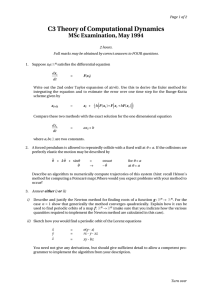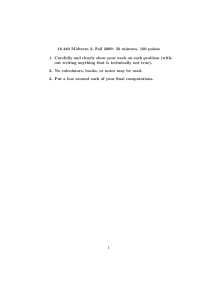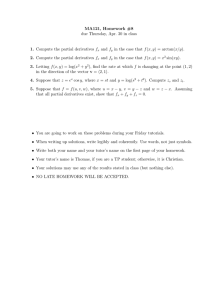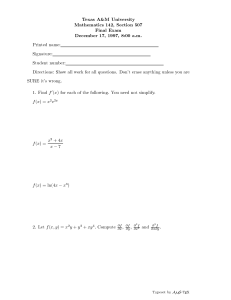McQuarrie, page 73, #2-5. monochromatic?
advertisement
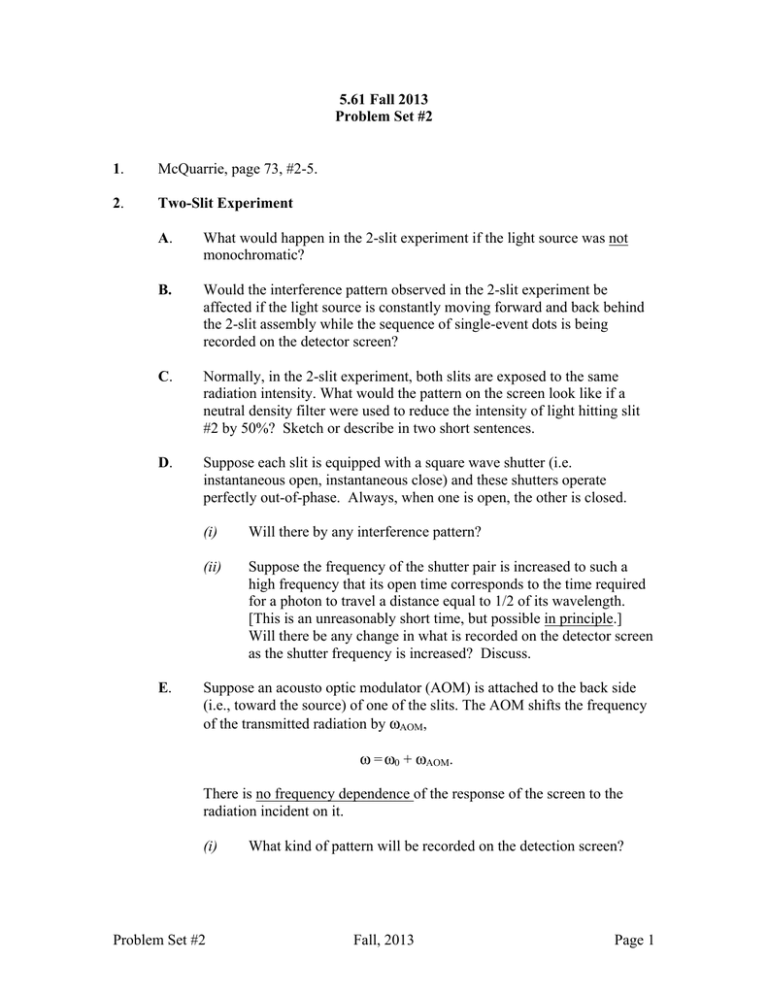
5.61 Fall 2013 Problem Set #2 1. McQuarrie, page 73, #2-5. 2. Two-Slit Experiment A. What would happen in the 2-slit experiment if the light source was not monochromatic? B. Would the interference pattern observed in the 2-slit experiment be affected if the light source is constantly moving forward and back behind the 2-slit assembly while the sequence of single-event dots is being recorded on the detector screen? C. Normally, in the 2-slit experiment, both slits are exposed to the same radiation intensity. What would the pattern on the screen look like if a neutral density filter were used to reduce the intensity of light hitting slit #2 by 50%? Sketch or describe in two short sentences. D. Suppose each slit is equipped with a square wave shutter (i.e. instantaneous open, instantaneous close) and these shutters operate perfectly out-of-phase. Always, when one is open, the other is closed. E. (i) Will there by any interference pattern? (ii) Suppose the frequency of the shutter pair is increased to such a high frequency that its open time corresponds to the time required for a photon to travel a distance equal to 1/2 of its wavelength. [This is an unreasonably short time, but possible in principle.] Will there be any change in what is recorded on the detector screen as the shutter frequency is increased? Discuss. Suppose an acousto optic modulator (AOM) is attached to the back side (i.e., toward the source) of one of the slits. The AOM shifts the frequency of the transmitted radiation by ωAOM, ω = ω0 + ωAOM. There is no frequency dependence of the response of the screen to the radiation incident on it. (i) Problem Set #2 What kind of pattern will be recorded on the detection screen? Fall, 2013 Page 1 (ii) Suppose that the light source is not quite monochromatic. It has a frequency width of Γ (ω lies within the region ω – Γ/2 to ω + Γ/2. Describe what will happen, if anything, to the pattern on the screen as ωAOM increases from ωAOM = Γ/2 ωAOM = 2Γ. to (iii) Discuss whether the possibility that light passing through slit #1 vs. slit #2 could, in principle, be distinguished by its frequency, would affect what is observed, even if the experiment actually performed does not make such a distinction. [HINT: This is a very subtle question.] 3. This problem deals with the 1-dimensional classical wave equation ∂2u 1 ∂2u = . ∂x 2 v2 ∂t 2 A string of length L is anchored so that u(x,t) = 0 at x = 0 and x = L. All of the answers are to be expressed in terms of L and v. A. Derive a general expression for u(x,t) as a linear superposition of “normal modes” of λ = 2L/n n = 1, 2, … ∞. B. Consider the square-wave “pluck” at t = 0 that has the form u ( x, 0 ) = 0 0≤x≤ u(x, 0) = 1 5 5 8 L and 7 7 8 L≤x≤L . L < x < L. 8 8 Express the pluck as an explicit linear combination of the normal modes. To do this you need to compute (or estimate) the overlap integral of this square-wave pluck with each of the n = 1-8 normal modes. C. Identify the 3 normal modes that make the largest contributions to this u(x,0) pluck and write the 3-term sum approximation of the moving wave, u(x,t). D. What is the earliest time, trecurrence, when u(x,trecurrence) = u(x,0)? Sketch u(x,trecurrence/2). Problem Set #2 Fall, 2013 Page 2 E. (optional) Make an eleven frame time-lapse movie of u(x,t) for ⎞ ⎛t t = m ⎜ recurrence ⎟ m = 0,1,…10 . It is OK to hand-sketch rather than ⎝ 10 ⎠ plot an explicit mathematical expression. The important thing is that all of the qualitative features are present. F. (optional) By comparing some features of the m = 0 and 1 frames of the movie, estimate the velocity of the traveling wave. G. Using the approximate superposition from part C, compute the timeL d dependent quantity x t = ∫ xu(x,t)dx and plot 〈x〉t and x t for the 0 dt time interval 0 ≤ t ≤ trecurrence. H. What do the plots in part G tell you about the evolution of the specific pluck? (Words like dephasing, rephasing, velocity, and spreading will be very welcome in your answer to this question.) I. Suppose a spatially narrower pluck u(x, 0) = 1 11 16 L<x< 13 16 L, or a centered pluck, u(x, 0) = 1 3 8 L<x< 5 8 L, were chosen. Suggest reasons for the qualitative differences between the time evolution of these plucks and that of the pluck documented in parts B through H? 4. A. Find the energies (En) and normalized wavefunctions (ψn) for a particle in an infinite (symmetric) box U(x) = 0 U(x) = ∞ B. –L/2 < x < L/2 |x| ≥ L/2. Relate the En and ψn for problem 4A to those for the (zero-left-edge) box. U(x) = 0 U(x) = ∞ 0<x<L x ≤ 0, x ≥ L. Define a simple coordinate transformation (e.g., x′ = ax + b) that makes the ψn for 4A look like those of 4B. Problem Set #2 Fall, 2013 Page 3 C. What happens to En and ψn if the box of 4A is raised to higher energy U(x) = E0 > 0 |x| < L/2 U(x) = ∞ |x| ≥ L/2 ? This should not require a repeat of the complete calculation analogous to that in part 4A. D. for Write a transformation (e.g., x′ = ax + b) that enables you to obtain the ψn U(x) = 0 U(x) = ∞ |x| < L |x| ≥ L from the ψn of 4A. This box is twice as long as the box in 4A. 5. For the particle in the box of 4B: A. Compute the probability of finding the particle in the interval 0.999 1.001 L≤x≤ L 2 2 for n = 1, 2, 3, and 104. B. Compute 〈x〉 and 〈p〉 for n = 1,2,3, and 104. [This should not require evaluation of any integrals.] C. Compute ∆x∆p for n = 1, 2, 104, where ∆x is the “uncertainty” in x. It is the square root of the variance ∆x =[〈x2〉 – 〈x〉2]1/2 and ∆p = [〈p2〉 – 〈p〉2]1/2. Hint: the values of 〈x〉, 〈p〉, and 〈p2〉 do not require evaluation of any integrals. Evaluation of 〈x2〉 will require use of integral tables or some other cleverness. Problem Set #2 Fall, 2013 Page 4 MIT OpenCourseWare http://ocw.mit.edu 5.61 Physical Chemistry Fall 2013 For information about citing these materials or our Terms of Use, visit: http://ocw.mit.edu/terms.

